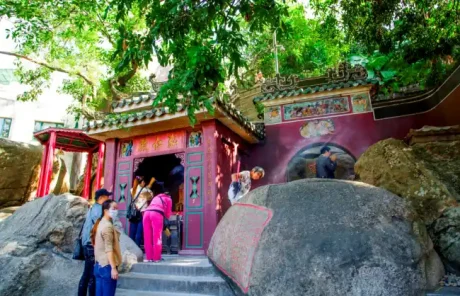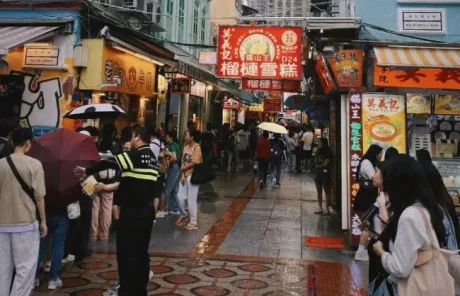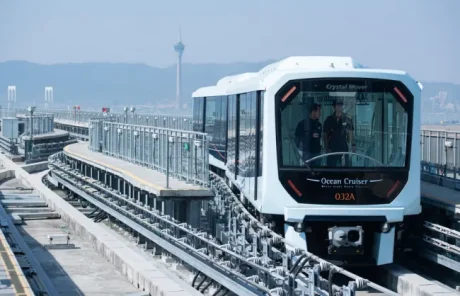Macau Travel Guide – An Ultimate Guide for First-timers in Macao
Macau, or Macao, officially known as the Macao Special Administrative Region of the People’s Republic of China, is located on the southeastern coast of mainland China. It lies to the south of Zhuhai City in Guangdong Province, and to the west of Hong Kong, across the sea. Now, they are connected by the Hong Kong-Zhuhai-Macau Bridge.
Covering a small size of 32.8 square kilometers, the region can be generally divided into two parts: the Macao Peninsula in the north and the Taipa Island and Coloane Island in the south. The islands of Taipa and Coloane have been joined through land reclamation to form the Cotai area, and are connected to the Macau Peninsula by several bridges.
As a famous gambling city with over 400 years of history of Portuguese colony, Macau is known for its unique casino culture, cuisine, blend of Eastern and Western cultures, vibrant nightlife, and rich historical architecture. Follow our Macau Travel Guide to learn how to best explore this most densely populated region in the world.

Chinese: 澳门 ào mén
Location: Southern China, located on the west bank of the Pearl River Delta
Population (urban area): 687,000 in 2024
Fast Facts of Macau
- Chinese name: 澳门(ào mén)
- Location: In the southwestern part of the Pearl River Delta, adjacent to Guangdong Province, 60 kilometers from Hong Kong.
- Population: 687,000 in 2024
- Area: 32.8 square kilometers
- Language: Cantonese, Mandarin, Portuguese, English
- Currency: Macanese Pataca (MOP), The exchange rate is approximately 8 Patacas to 1 US dollar, and 103 Patacas to 100 Hong Kong dollars.
- Time in Macau: In the UTC/GMT +8 hours time zone
- Climate: Subtropical monsoon climate
- Best time to visit: October to April of the next year
- How many days needed: 1-3 days
- Why visit: Rich UNESCO sites and cultural heritage, diverse culinary delights, a famous gambling center, easy accessibility…
Macau History
According to the burial sites discovered on Coloane Island, the history of Macau can be traced back to 3000 BCE to 1000 BCE . From the Song Dynasty, it was part of Xiangshan County in Guangdong.
Then, during the Age of Exploration, the Portuguese obtained the right to reside here. In 1887, after they signed the “Sino-Portuguese Treaty of Amity and Commerce” with the Qing Dynasty government, Macao formally became a Portuguese colony.
During the colony period, the Portuguese culture profoundly influenced its architecture, religion, language, and lifestyle. In the 20th century, Macau’s gaming industry began to flourish, and gradually surpassed its importance as a trading center.
In 1999, it returned to China and became a Special Administrative Region of China. Its position as a global gaming center remained.
In 2005, the Historic Centre, with over 20 historic buildings, was inscribed as a UNESCO World Heritage site. Then in 2017, it received the title of “City of Gastronomy” from UNESCO for its prestigious and diverse cuisines. Its well-developed light industry, tourism, hospitality, and entertainment industries make the city a popular destination for a China tour.
Popular Attractions in Macau
Macau boasts rich historical heritage and modern integrated resorts. The Macau Peninsula is where its Historical Center is located, housing most of its historical heritage and UNESCO-listed sites. Taipa Island is where its modern resorts, shopping centers and historical sites co-exist. Coloane Island in the southmost is more renowned for its natural scenery and tranquil environment.
Cotai, the new area joining Taipa and Coloane through land reclamation, is the most modern and luxurious area of the region. This new hotspot is where you can encounter many luxurious hotels, shopping centers, entertainment facilities, and casinos.
The Venetian Macao
Located in the Cotai Strip reclamation area, the Venetian Macao is on a grander scale than the Venetian Hotel in Las Vegas. It is known for its iconic architecture, massive shopping mall, luxury hotel rooms, and particularly, the indoor Grand Canal with gondola rides. Its casino boasts one of the largest ones in the world.
Macau Tower
Once the tenth tallest independent observation tower in the world, the main observation deck of Macau Tower offers a spectacular panoramic view of the entire city. It houses a 360° revolving restaurant on the 60th floor. Visitors can also challenge the world’s highest SkyJump and bungee jumping here.
Giant Panda Pavilion
The entire Giant Panda Pavilion covers an area of about 3,000 square meters, in a fan-shaped layout. It is currently home to a family of four pandas. There is an information center offering informative displays about pandas. The Rare Animal Pavilion adjacent to the panda pavilion houses some red pandas and golden monkeys.
Taipa Village
Compared to the traditional tranquil village, Taipa Village is more like a diverse area blending old architecture, traditional lifestyles, and modern commerce. As a former residential area of the Portuguese, it is filled with rich Portuguese-style buildings and cultural features. The wide array of dining options make it a top place to eat in Macau.
Fisherman's Wharf
Modeled after the fisherman's wharves of Europe and America, Macao Fisherman's Wharf is a top theme park and shopping center in the region. It is divided into three themed areas: Tang Dynasty Village, East Meets West, and Legend Wharf. Cultural events and entertainment performances are frequently held here.
Macau Museum
Adjacent to the Ruins of St. Paul's, the Macao Museum is like a vibrant encyclopedia, showcasing the region's diverse religious beliefs, traditional customs, and dynamic past. Its exhibits and artifacts cover various aspects. The museum building itself is an artwork, featuring a contemporary design.
City of Dreams
Located on the Cotai Strip, The City of Dreams is a luxurious integrated resort offering a range of top-notch facilities and services. Three world-class themed hotels are included in the resort. The over 20 high-end restaurants and bars, along with a variety of gambling games, ensure your ultimate entertainment.
Hac Sa Beach
The beach is on the southern side of Coloane Island, known for its unique back sand. It is the largest natural beach in the region, offering a variety of water activities and great spots for stargazing. Nearby the beach is a century-old fishing village named Hac Sa Village, offering a historical charm.
Top Things to Do in Macau
Play at Casinos
A highlight of traveling to Macau is its unique gambling culture. As one of the largest gambling centers in the world, it draws visitors from around the world with a wide range of luxurious casinos and entertainment venues. Typically, most casinos here include three main areas, which are the general gaming area, high-stakes gaming area and Texas Hold’em area. The general and high-stakes areas can be further divided into the machine area and the dealer area. Each area offers a variety of gambling games with different minimum bets.
Popular casinos: Grand Lisboa, The Venetian Macao, Wynn Palace, Galaxy Macau, City of Dreams, and MGM Macau and Sands.
Snack on Rua do Cunha
As a “City of Gastronomy”, Macao food will surely not disappoint you. When mentioning great food streets in Macao, the Rua do Cunha is always listed. Located on Taipa Island, the street stretches about 115 meters and is lined with numerous restaurants, food stalls, and souvenir shops. The distinct Chinese and Western-styled buildings along the street add an old charm to the street.
Wander around Macau’s Historical Centre
A core area in Macao Peninsula, the Historic Center offers an insight into the essence of over 400 years of cultural exchanges here. It is home to 8 squares and 22 historic buildings. Most buildings here are in Western style and decorated with rich Chinese elements. In 2005, this area has been inscribed on the UNESCO World Heritage List. The famous Ruins of St. Paul’s, A-Ma Temple, and Largo do Senado are all included in the Historic Center.
Dine at a Michelin-starred Restaurant
Macau boasts 16 Michelin-starred restaurants in 2024. While the colorful street food offers so much fun, these Michelin-starred restaurants offer the extremely high-end culinary scene of this region.
Visit the Science Center
The Science Center is especially recommended for those who travel to Macau with kids, located in the southeastern corner of the Macau Peninsula. Designed by the renowned architect I.M. Pei, the center exudes a strong sense of modern technology from the outside. It consists of three main parts: the inclined cone-shaped Exhibition Center, the hemispherical Planetarium, and the Conference Center.
Enjoy Your Time at the Cotai Strip
The Cotai Strip is where you can look into the most luxurious and bustling aspects of Macao. This emerging area serves as a hub of casinos, luxury hotels, shopping, and a variety of dining, and entertainment. It is similar to the Las Vegas Strip. Not only bustling during the day, it also offers enchanting night views as the neon lights illuminate the surrounding buildings. Landmarks here include the Eiffel Tower, Galaxy Macau, the Venetian, etc. The spectacular water show – The House of Dancing Water is a must-see.
Recommended China tours including Macau:

Macau Currency
Macanese Pataca (MOP) is the official currency of Macau. The exchange rate is around 8 MOP to the USD. The 7 denominations of the banknote are 10, 20, 50, 100, 500, and 1000 Patacas. And the coins come in 10, 20, and 50 avos, and 1, 2, 5, and 10 Patacas.
It’s easy to exchange currency at the airport, ferry terminals, most hotels, and banks. Electronic transactions are common here, with most major credit cards accepted.
Transportation: How to Get to & Travel Around
How to Get to
Air, ferry and coach are the most common ways to get to Macau. Currently, there is no train services between Macao and mainland China.
By air
Flying to Macau International Airport is the most convenient way. Currently, the airport offers many international flights to/from Southeast Asia and East Asia countries. Flights from most domestic cities can also fly directly here. If your destination has no direct flights, it is also convenient to fly to Hong Kong, Shenzhen, and Zhuhai before transferring to Macao.
By ferry
Macau Outer Ferry Terminal (in Macao Peninsula) and Macau Taipa Ferry Terminal (in Cotai) are the two most used terminals in Macao. Currently, visitors can take ferries to Macao from Shekou Cruise Homeport or Shenzhen Airport Ferry Terminal in Shenzhen, Hong Kong Macau Ferry Terminal, Hong Kong SkyPier, and Hong Kong – China Ferry Terminal.
From Zhuhai, visitors can walk across the Gongbei Port to enter the Macao Peninsula. Or take a 5-minute ferry from Wanzai Port to the Macau Peninsula.
By bus
From Hengqin Port in Zhuhai, visitors can take a bus to different hotels and casinos in Macao in about 30 minutes.
From Hong Kong, you can take the Hong Kong-Macau Express from the Cross-Boundary Coach Terminus in Kowloon MTR to several hotels in Macao. Or, take the CTS Bus from Kowloon (with few points) to The Venetian Macao, MGM Cotai, and Galaxy Hotel in about 45 minutes. HZMB Shuttle Bus (Golden Bus) running between the Hong Kong-Zhuhai-Macau Bridge Hong Kong Port and the Macau Port is currently the cheapest option between these two destinations.
How to Travel Around
Free Shuttle Bus
Many hotels offer free shuttle bus services, allowing visitors to conveniently transfer from major ports, airport, and key areas.
Light Rail
Currently, only one light rail line is available, with 12 stations connecting Macao Peninsula, Cotai, Airport, and Taipa. You can buy tickets from manned ticket counters, or self-service machines, or simply tap your Macau Pass (available at many retail stores and supermarkets.) to enter. The fares are as below:
- 0-3 stations: 6 MOP
- 4-6 stations: 8 MOP
- 7-9 stations: 10 MOP
- 10-12 stations: 12 MOP
Public Buses
Public buses are frequent and convenient, you can download the App. Bus Traveling System (巴士報站) to get all bus routes and traffic conditions. The bus fares are also affordable, generally 6 MOP per trip if paid by cash, and 3 MOP per trip by Macau Pass.
Taxi
Taxis are quick and convenient, but more expensive. Visitors can hail a taxi from hotel taxi stands, or designated taxi stops. Most drivers accept cash only, in MOP, RMB, and HKD. The starting fare for red taxis is 19 MOP, and 24 MOP for blue taxis.

Best Time to Visit
The best times to visit Macau are autumn and winter, from October to February the next year. These seasons are when it enjoys the most comfortable weather of the year. In winter, temperatures rarely drop below 5°C. Spring (April to May) is warm but often foggy. Summer is often hot and rainy, but offers a great time to Hac Sa Beach.
Please be aware of the occasional typhoons in summer. Flights and ferries in the surrounding areas may be temporarily suspended as a typhoon approaches. Thus, always check the latest weather forecast if plan to visit Macau during this period.
Food
Trying the street food should be a great way to understand Macao’s culture. All the streets here are filled with enticing delicacies reflecting its rich heritage. During a Macau tour, don’t-miss the following street foods:
- Pork Chop Bun: Boil and fry the pork chop and pair it with bun and butter. Recommended restaurant: Cafe Tai Lei Loi Kei in Taipa, the birthplace of pork chop bun.
- Jerky: Marinate pork or beef with special spices, and grill it to perfection. There are numerous jerky shops on any food street here.
- Almond Cookies: A popular local souvenir. Koi Kei Bakery is a famous brand for authentic almond cookies.
- Portuguese Chicken: Slowly cook the chicken with potatoes, bell peppers, and a special Portuguese sauce. Restaurante Litoral is an old establishment serving this dish.
- Shrimp Roe Noodles: With golden shrimp roe put atop the noodles, this dish offers a delightful crunch and unique taste. Recommended spot: The old restaurant Wong Chi Kei.
- Bacalhau: A traditional dish made with cod, potato flour, onions, and bell peppers. Recommended restaurant: 30-year-old A Lorcha, Michelin recommended.
- Egg Tarts: Feature crispy layers and silky custard. Lord Stow’s Bakery is highly recommended by locals.
Food tips: Three Lamps District and Senodo Square Area in the Peninsula and Rua do Cunha in Taipa are the top recommended culinary districts to experience the city’s diverse flavors and vibrant food scene.
Accommodation: Where to Stay and Recommended Hotels
While Macao is small in size, it offers plenty of attractions. If you’re limited in time, it’s possible to get an overview of the region in one day. However, we highly recommended to stay at least one night here to truly experience its magic nightlife.
Most hotels in Macau are concentrated in the Peninsula and Taipa areas. Below are some recommended ones with convenient transportation, a variety of dining options, and entertainment facilities.
- Recommended Hotels in Cotai: The Venetian Macao Resort Hotel, The Parisian Macao, Studio City, Sheraton Grand Macao, Galaxy Macau, Wynn Palace
- Recommended Hotels in the Peninsula: Emperor Hotel, Mandarin Oriental, MGM Macau, Grand Lisboa Hotel, Hotel Royal Macau.
Macau Travel Visa
Currently, citizens of 81 foreign countries and regions can visit to Macao visa-free for a certain period as long as they hold the required documents (like valid passports, and proof of onward and return flights). And most of the other countries can visit here by obtaining a visa on arrival or before arriving.









